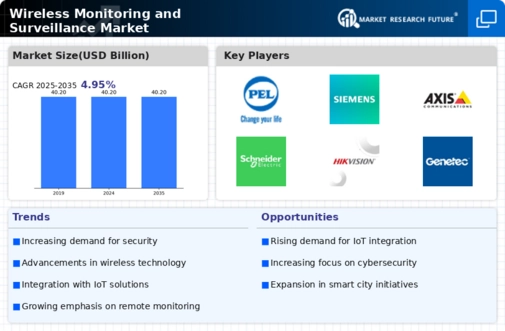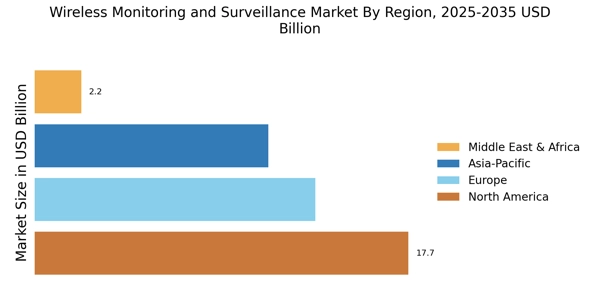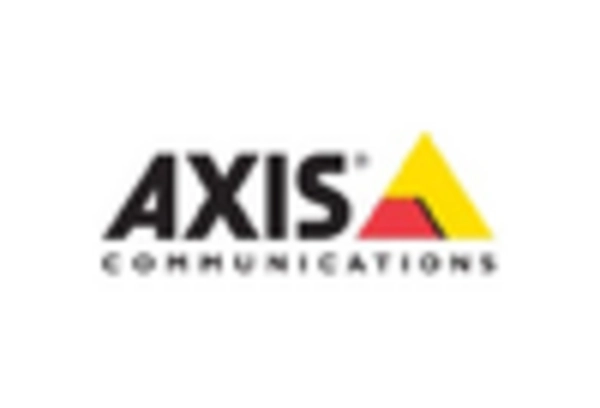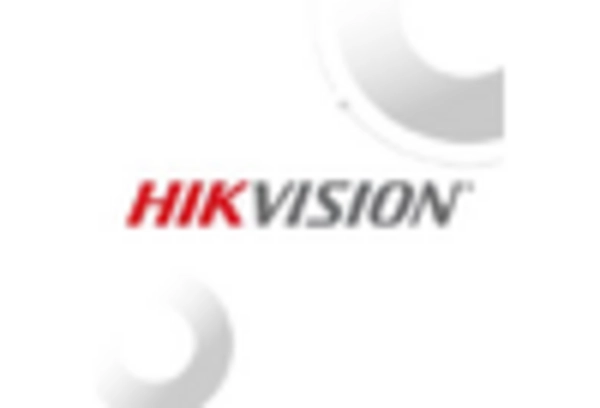Growth of Smart Cities
The emergence of smart cities is a significant driver for the Wireless Monitoring and Surveillance Market. As urban areas evolve into interconnected ecosystems, the need for efficient monitoring and surveillance systems becomes increasingly apparent. Smart city initiatives often incorporate advanced surveillance technologies to enhance public safety, traffic management, and urban planning. The integration of wireless monitoring solutions allows city officials to monitor public spaces in real-time, facilitating quicker responses to incidents and improving overall safety. This trend is expected to propel the market forward, as municipalities invest in smart surveillance systems that contribute to the development of safer and more efficient urban environments. Consequently, the Wireless Monitoring and Surveillance Market stands to gain from the growing emphasis on smart city infrastructure.
Technological Advancements
Technological advancements play a pivotal role in shaping the Wireless Monitoring and Surveillance Market. Innovations in camera technology, such as high-definition imaging and night vision capabilities, have significantly improved the effectiveness of surveillance systems. Furthermore, the integration of cloud computing and mobile applications allows users to access surveillance feeds remotely, enhancing convenience and operational efficiency. The market is expected to witness a notable increase in the adoption of smart cameras equipped with artificial intelligence, which can analyze video feeds for suspicious activities. This trend indicates a shift towards more sophisticated surveillance solutions that not only capture footage but also provide actionable insights. As technology continues to evolve, the Wireless Monitoring and Surveillance Market is likely to benefit from these advancements, leading to increased market penetration and user adoption.
Increasing Security Concerns
The Wireless Monitoring and Surveillance Market is experiencing a surge in demand due to escalating security concerns across various sectors. Organizations are increasingly investing in advanced surveillance systems to mitigate risks associated with theft, vandalism, and unauthorized access. According to recent data, the market is projected to grow at a compound annual growth rate of approximately 10% over the next five years. This growth is driven by the need for enhanced security measures in residential, commercial, and industrial environments. As crime rates fluctuate, the urgency for reliable monitoring solutions becomes paramount, prompting businesses and homeowners alike to adopt wireless technologies that offer real-time surveillance capabilities. Consequently, the Wireless Monitoring and Surveillance Market is poised for substantial expansion as stakeholders prioritize safety and security.
Regulatory Compliance and Standards
The Wireless Monitoring and Surveillance Market is significantly influenced by regulatory compliance and standards that govern surveillance practices. Governments and regulatory bodies are increasingly implementing stringent guidelines to ensure data protection and privacy in surveillance operations. This has led organizations to invest in compliant monitoring solutions that adhere to legal requirements. For instance, the General Data Protection Regulation (GDPR) in Europe has prompted businesses to adopt surveillance systems that prioritize data security and user consent. As compliance becomes a critical factor, the demand for surveillance technologies that align with these regulations is expected to rise. This trend not only enhances consumer trust but also drives innovation within the Wireless Monitoring and Surveillance Market, as companies strive to develop solutions that meet evolving legal standards.
Rising Demand for Remote Monitoring
The Wireless Monitoring and Surveillance Market is witnessing a rising demand for remote monitoring solutions, driven by the need for flexibility and accessibility. Businesses and individuals are increasingly seeking systems that allow them to monitor their properties from anywhere, at any time. This trend is particularly evident in sectors such as retail, where store owners require real-time insights into customer behavior and security. The proliferation of mobile devices and applications has facilitated this shift, enabling users to access surveillance feeds seamlessly. As remote monitoring becomes a standard expectation, the market is likely to expand, with more companies offering innovative solutions that cater to this demand. This evolution reflects a broader shift towards convenience and efficiency in the Wireless Monitoring and Surveillance Market.


















Leave a Comment